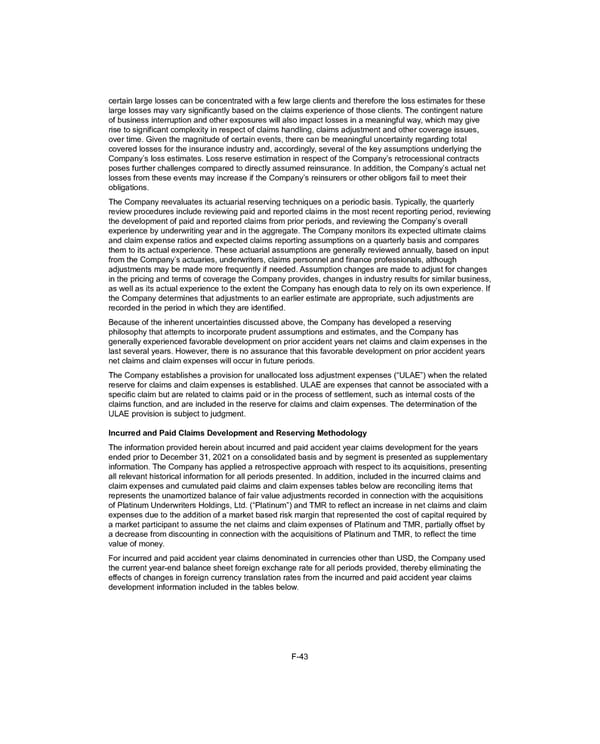certain large losses can be concentrated with a few large clients and therefore the loss estimates for these large losses may vary significantly based on the claims experience of those clients. The contingent nature of business interruption and other exposures will also impact losses in a meaningful way, which may give rise to significant complexity in respect of claims handling, claims adjustment and other coverage issues, over time. Given the magnitude of certain events, there can be meaningful uncertainty regarding total covered losses for the insurance industry and, accordingly, several of the key assumptions underlying the Company’s loss estimates. Loss reserve estimation in respect of the Company’s retrocessional contracts poses further challenges compared to directly assumed reinsurance. In addition, the Company’s actual net losses from these events may increase if the Company’s reinsurers or other obligors fail to meet their obligations. The Company reevaluates its actuarial reserving techniques on a periodic basis. Typically, the quarterly review procedures include reviewing paid and reported claims in the most recent reporting period, reviewing the development of paid and reported claims from prior periods, and reviewing the Company’s overall experience by underwriting year and in the aggregate. The Company monitors its expected ultimate claims and claim expense ratios and expected claims reporting assumptions on a quarterly basis and compares them to its actual experience. These actuarial assumptions are generally reviewed annually, based on input from the Company’s actuaries, underwriters, claims personnel and finance professionals, although adjustments may be made more frequently if needed. Assumption changes are made to adjust for changes in the pricing and terms of coverage the Company provides, changes in industry results for similar business, as well as its actual experience to the extent the Company has enough data to rely on its own experience. If the Company determines that adjustments to an earlier estimate are appropriate, such adjustments are recorded in the period in which they are identified. Because of the inherent uncertainties discussed above, the Company has developed a reserving philosophy that attempts to incorporate prudent assumptions and estimates, and the Company has generally experienced favorable development on prior accident years net claims and claim expenses in the last several years. However, there is no assurance that this favorable development on prior accident years net claims and claim expenses will occur in future periods. The Company establishes a provision for unallocated loss adjustment expenses (“ULAE”) when the related reserve for claims and claim expenses is established. ULAE are expenses that cannot be associated with a specific claim but are related to claims paid or in the process of settlement, such as internal costs of the claims function, and are included in the reserve for claims and claim expenses. The determination of the ULAE provision is subject to judgment. Incurred and Paid Claims Development and Reserving Methodology The information provided herein about incurred and paid accident year claims development for the years ended prior to December 31, 2021 on a consolidated basis and by segment is presented as supplementary information. The Company has applied a retrospective approach with respect to its acquisitions, presenting all relevant historical information for all periods presented. In addition, included in the incurred claims and claim expenses and cumulated paid claims and claim expenses tables below are reconciling items that represents the unamortized balance of fair value adjustments recorded in connection with the acquisitions of Platinum Underwriters Holdings, Ltd. (“Platinum”) and TMR to reflect an increase in net claims and claim expenses due to the addition of a market based risk margin that represented the cost of capital required by a market participant to assume the net claims and claim expenses of Platinum and TMR, partially offset by a decrease from discounting in connection with the acquisitions of Platinum and TMR, to reflect the time value of money. For incurred and paid accident year claims denominated in currencies other than USD, the Company used the current year-end balance sheet foreign exchange rate for all periods provided, thereby eliminating the effects of changes in foreign currency translation rates from the incurred and paid accident year claims development information included in the tables below. F-43
 2021 Annual Report Page 185 Page 187
2021 Annual Report Page 185 Page 187